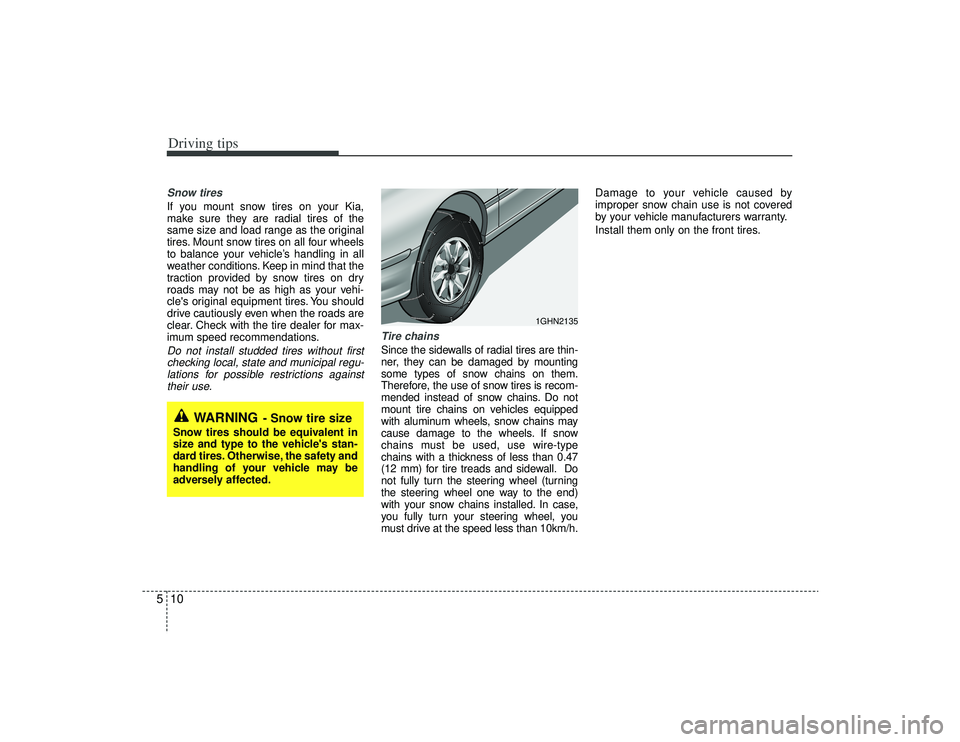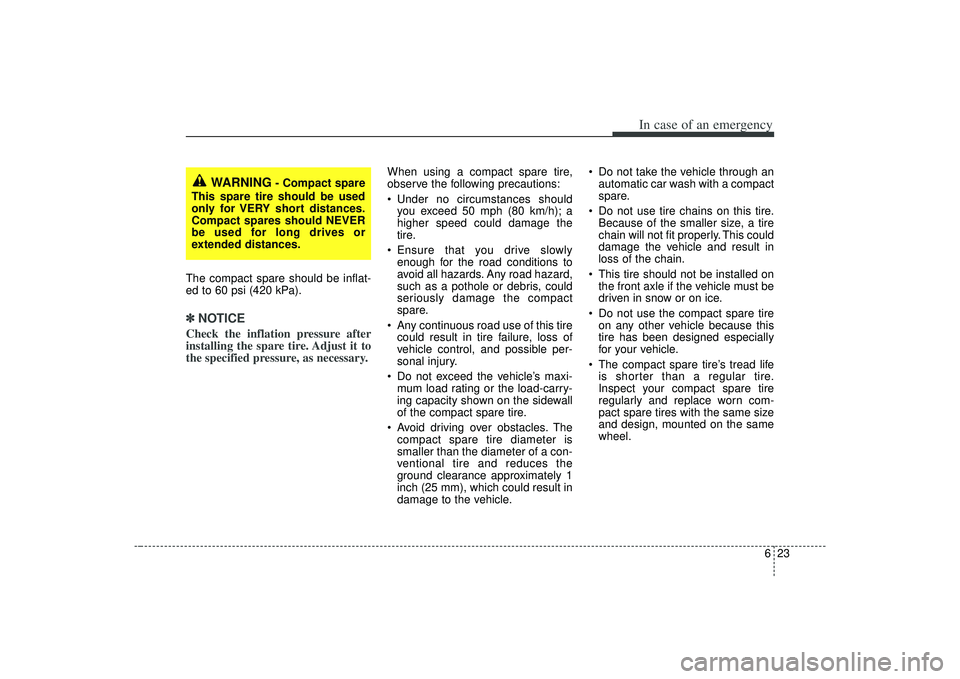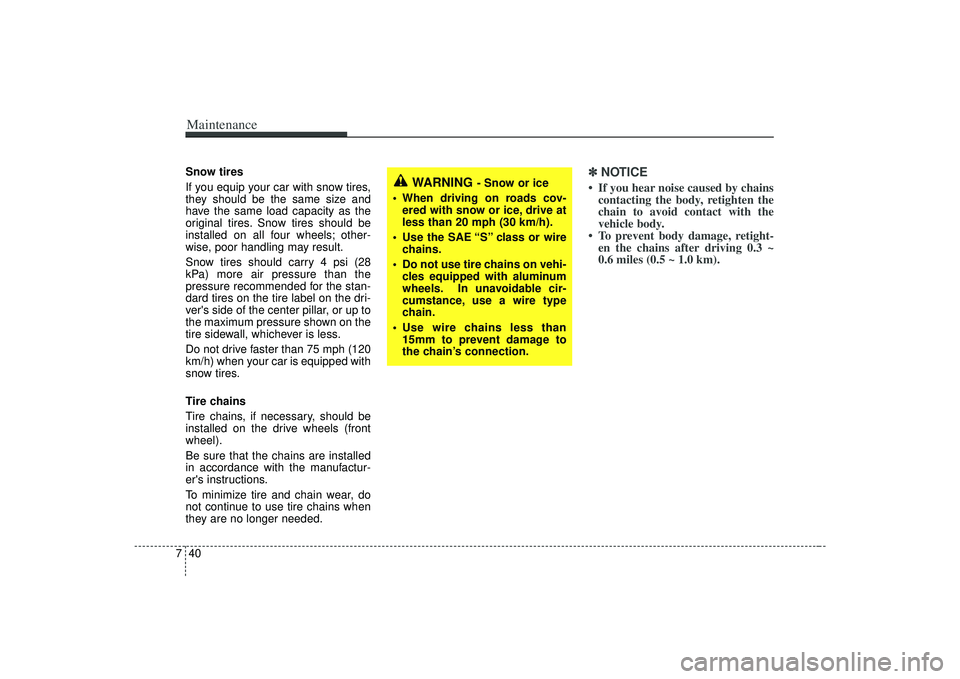2009 KIA AMANTI snow chains
[x] Cancel search: snow chainsPage 199 of 321

57
Driving tips
SPECIAL DRIVING CONDITIONS Hazardous driving conditions When hazardous driving conditions are
encountered such as water, snow, ice,
mud, sand, or similar hazards, follow
these suggestions:
Drive cautiously and allow extra dis-tance for braking.
Avoid sudden movements in braking or steering.
When braking, pump the brake pedal with a light up-and-down motion until
the vehicle is stopped.✽ ✽ NOTICEDo not pump the brake pedal on a vehi-
cle equipped with ABS.
If stalled in snow, mud, or sand, use
second gear. Accelerate slowly to
avoid spinning the drive wheels.
Use sand, rock salt, tire chains, or other non-slip material under the drive
wheels to provide traction when stalled
in ice, snow, or mud.
Rocking the vehicle If it is necessary to rock the vehicle to
free it from snow, sand, or mud, first turn
the steering wheel right and left to clear
the area around your front wheels. Then,
shift back and forth between R (Reverse)
and any forward gear in vehicles
equipped with an automatic transaxle. Do
not race the engine, and spin the wheels
as little as possible. If you are still stuck
after a few tries, have the vehicle pulled
out by a tow vehicle to avoid engine
overheating and possible damage to the
transaxle.
WARNING
- Downshifting
Downshifting with an automatic
transaxle, while driving on slippery
surfaces can cause an accident.
The sudden change in tire speed
could cause the tires to skid. Be
careful when downshifting on slip-
pery surfaces.
Page 202 of 321

Driving tips10
5Snow tires If you mount snow tires on your Kia,
make sure they are radial tires of the
same size and load range as the original
tires. Mount snow tires on all four wheels
to balance your vehicle’s handling in all
weather conditions. Keep in mind that the
traction provided by snow tires on dry
roads may not be as high as your vehi-
cle's original equipment tires. You should
drive cautiously even when the roads are
clear. Check with the tire dealer for max-
imum speed recommendations.Do not install studded tires without first
checking local, state and municipal regu- lations for possible restrictions againsttheir use. Tire chains
Since the sidewalls of radial tires are thin-
ner, they can be damaged by mounting
some types of snow chains on them.
Therefore, the use of snow tires is recom-
mended instead of snow chains. Do not
mount tire chains on vehicles equipped
with aluminum wheels, snow chains may
cause damage to the wheels. If snow
chains must be used, use wire-type
chains with a thickness of less than 0.47
(12 mm) for tire treads and sidewall. Do
not fully turn the steering wheel (turning
the steering wheel one way to the end)
with your snow chains installed. In case,
you fully turn your steering wheel, you
must drive at the speed less than 10km/h. Damage to your vehicle caused by
improper snow chain use is not covered
by your vehicle manufacturers warranty.
Install them only on the front tires.
WARNING
- Snow tire size
Snow tires should be equivalent in
size and type to the vehicle's stan-
dard tires. Otherwise, the safety and
handling of your vehicle may be
adversely affected.
1GHN2135
Page 203 of 321

511
Driving tips
Chain installation
When installing chains, follow the manu-
facturer's instructions and mount them as
tightly as you can. Drive slowly with
chains installed. If you hear the chains
contacting the body or chassis, stop and
tighten them. If they still make contact,
slow down until it stops. Remove the
chains as soon as you begin driving on
cleared roads.
CAUTION
Make sure the snow chains arethe correct size and type for yourtires. Incorrect snow chains cancause damage to the vehicle body and suspension and may not becovered by your vehicle manufac-turer warranty. Also, the snow chain connecting hooks may bedamaged from contacting vehiclecomponents causing the snowchains to come loose from the tire. Make sure the snow chainsare SAE class “S” certified. Cable-type, or plastic-type snow chain can also be used.
Always check chain installation for proper mounting after drivingapproximately 0.5 to 1 km to ensure safe mounting. Retightenor remount the chains if they areloose.
WARNING
When mounting snow chains, park
the vehicle on level ground away
from traffic. Turn on the vehicle
Hazard Warning flashers and place
a triangular emergency warning
device behind the vehicle if avail-
able. Always place the vehicle in
park (P), apply the parking brake
and turn off the engine before
installing snow chains.
WARNING
- Tire chains
The use of chains may adversely affect vehicle handling.
Do not exceed 20 mph (30 km/h) or the chain manufacturer’s rec-
ommended speed limit, whichev-
er is lower.
Drive carefully and avoid bumps, holes, sharp turns, and other road
hazards, which may cause the
vehicle to bounce.
Avoid sharp turns or locked- wheel braking.
Chains that are the wrong size or improperly installed can damage
your vehicle's brake lines, sus-
pension, body and wheels.
Stop driving and retighten the chains any time you hear them
hitting the vehicle.
Page 242 of 321

619
In case of an emergency
TPMS (Tire Pressure
Monitoring System)
malfunction indicator
The TPMS malfunction indicator
turns on and stays on when there is
a problem with the Tire Pressure
Monitoring System. If the system is
able to correctly detect an under-
inflation warning at the same time as
system failure then it will illuminate
both the TPMS malfunction and the
low tire pressure telltale e.g. if Front
Left sensor fails, the TPMS malfunc-
tion indicator turns, but if Front Right,
Rear Left, or Rear Right tire is under-
inflated, the low tire pressure telltale
may turn on at the same time as the
TPMS malfunction indicator.
Have the system checked by an
authorized KIA dealer as soon as
possible to determine the cause of
the problem.
✽ ✽NOTICE• The TPMS malfunction indicator
may be illuminated if the vehicle is
moving around electric power sup-
ply cable or radio transmitter such
as police stations, government and
public offices, broadcasting sta-
tions, military installations, air-
ports, or transmitting tower, etc.
this can interfere with normal
operation of the Tire Pressure
Monitoring System (TPMS).
• The TPMS malfunction indicator may be illuminated if snow chains
or some electronic devices, such as
notebook computers, are used in
the vehicle. This can interfere with
normal operation of the Tire
Pressure Monitoring System
(TPMS). (Continued)(Continued)
• If there is a failed tire sensor, it is
possible for the TPMS to tem-
porarily learn a replacement sen-
sor if closely driven to another
vehicle that is also equipped with
TPMS. In rare cases, this may
temporarily delay the TPMS mal-
function indicator from turning
on.
TPMS
Page 246 of 321

623
In case of an emergency
The compact spare should be inflat-
ed to 60 psi (420 kPa).✽ ✽NOTICECheck the inflation pressure after
installing the spare tire. Adjust it to
the specified pressure, as necessary.
When using a compact spare tire,
observe the following precautions:
Under no circumstances should
you exceed 50 mph (80 km/h); a
higher speed could damage the
tire.
Ensure that you drive slowly enough for the road conditions to
avoid all hazards. Any road hazard,
such as a pothole or debris, could
seriously damage the compact
spare.
Any continuous road use of this tire could result in tire failure, loss of
vehicle control, and possible per-
sonal injury.
Do not exceed the vehicle’s maxi- mum load rating or the load-carry-
ing capacity shown on the sidewall
of the compact spare tire.
Avoid driving over obstacles. The compact spare tire diameter is
smaller than the diameter of a con-
ventional tire and reduces the
ground clearance approximately 1
inch (25 mm), which could result in
damage to the vehicle. Do not take the vehicle through an
automatic car wash with a compact
spare.
Do not use tire chains on this tire. Because of the smaller size, a tire
chain will not fit properly. This could
damage the vehicle and result in
loss of the chain.
This tire should not be installed on the front axle if the vehicle must be
driven in snow or on ice.
Do not use the compact spare tire on any other vehicle because this
tire has been designed especially
for your vehicle.
The compact spare tire’s tread life is shorter than a regular tire.
Inspect your compact spare tire
regularly and replace worn com-
pact spare tires with the same size
and design, mounted on the same
wheel.
WARNING
- Compact spare
This spare tire should be used
only for VERY short distances.
Compact spares should NEVER
be used for long drives or
extended distances.
Page 290 of 321

Maintenance40
7Snow tires
If you equip your car with snow tires,
they should be the same size and
have the same load capacity as the
original tires. Snow tires should be
installed on all four wheels; other-
wise, poor handling may result.
Snow tires should carry 4 psi (28
kPa) more air pressure than the
pressure recommended for the stan-
dard tires on the tire label on the dri-
ver's side of the center pillar, or up to
the maximum pressure shown on the
tire sidewall, whichever is less.
Do not drive faster than 75 mph (120
km/h) when your car is equipped with
snow tires.
Tire chains
Tire chains, if necessary, should be
installed on the drive wheels (front
wheel).
Be sure that the chains are installed
in accordance with the manufactur-
er's instructions.
To minimize tire and chain wear, do
not continue to use tire chains when
they are no longer needed.
✽ ✽
NOTICE• If you hear noise caused by chains
contacting the body, retighten the
chain to avoid contact with the
vehicle body.
• To prevent body damage, retight- en the chains after driving 0.3 ~
0.6 miles (0.5 ~ 1.0 km).
WARNING
- Snow or ice
When driving on roads cov- ered with snow or ice, drive at
less than 20 mph (30 km/h).
Use the SAE “S” class or wire chains.
Do not use tire chains on vehi- cles equipped with aluminum
wheels. In unavoidable cir-
cumstance, use a wire type
chain.
Use wire chains less than 15mm to prevent damage to
the chain’s connection.
Page 319 of 321

Index8
10
Seat··················\
··················\
··················\
··················\
·········3-17Adjustment ··················\
··················\
··················\
············3-19
Warming and Ventilating the Front ··················\
···········3-23
Snow Tires ··················\
··················\
··················\
······5-10, 7-40
Spare Tire, Removing the ··················\
··················\
··········6-22
Special Driving Conditions ··················\
··················\
·········5-7
Specifications ··················\
··················\
··················\
·············8-2 Lubricant··················\
··················\
··················\
················7-46
Speedometer··················\
··················\
··················\
·············4-26
Starting Emergency, Jump ··················\
··················\
··················\
····6-4
the Engine ··················\
··················\
··················\
················4-4
Steering Column Lock, Ignition Switch and Anti-Theft ·············4-2
Power ··················\
··················\
··················\
···········4-17, 7-17
Wheel ··················\
··················\
··················\
··················\
···4-17
Tilt··················\
··················\
··················\
··················\
········4-18
Storage Compartments··················\
··················\
···············3-89
Suggestions for Economical Operation ··················\
·········5-6
Storing the Jack and Tools ··················\
··················\
·········6-22
Storing the Spare Tire ··················\
··················\
················6-22
Sunglass Holder ··················\
··················\
··················\
·······3-90
Sunroof··················\
··················\
··················\
··················\
···3-96
Sunvisor ··················\
··················\
··················\
··················\
·3-93
Switch, Ignition··················\
··················\
··················\
··········4-2 Tachometer··················\
··················\
··················\
···············4-26
Temperature
Control Knob ··················\
··················\
··················\
·········4-48
Gauge, Engine ··················\
··················\
··················\
·······4-26
Tilt Steering ··················\
··················\
··················\
·············4-18
Tips for Towing a Stuck Vehicle ··················\
·················6-17\
Tire and Wheels ··················\
··················\
··················\
············7-29
Balance, Wheel Alignment and ··················\
·················7-32\
Care··················\
··················\
··················\
··················\
······7-29
Chains··················\
··················\
··················\
···········5-10, 7-40
Changing··················\
··················\
··················\
················6-24
Pressure Monitoring System (TPMS) ················4-37, 6-\
17
Quality Grading, Uniform ··················\
··················\
·······7-36
Replacement ··················\
··················\
··················\
·6-24, 7-32
Rotation ··················\
··················\
··················\
·················7-31\
Size Designation ··················\
··················\
··················\
····7-34
Snow··················\
··················\
··················\
·············5-10, 7-40
Speed Ratings ··················\
··················\
··················\
········7-35
Specifications ··················\
··················\
··················\
··········8-3
Toll-Free Consumer Assistance ··················\
··················\
···9-2
Towing ··················\
··················\
··················\
··················\
···6-13 With a Vehicle Other Than a Tow Truck··················\
···6-15
Trailer Brakes ··················\
··················\
··················\
··················\
··5-21
Driving with a··················\
··················\
··················\
········5-21
T